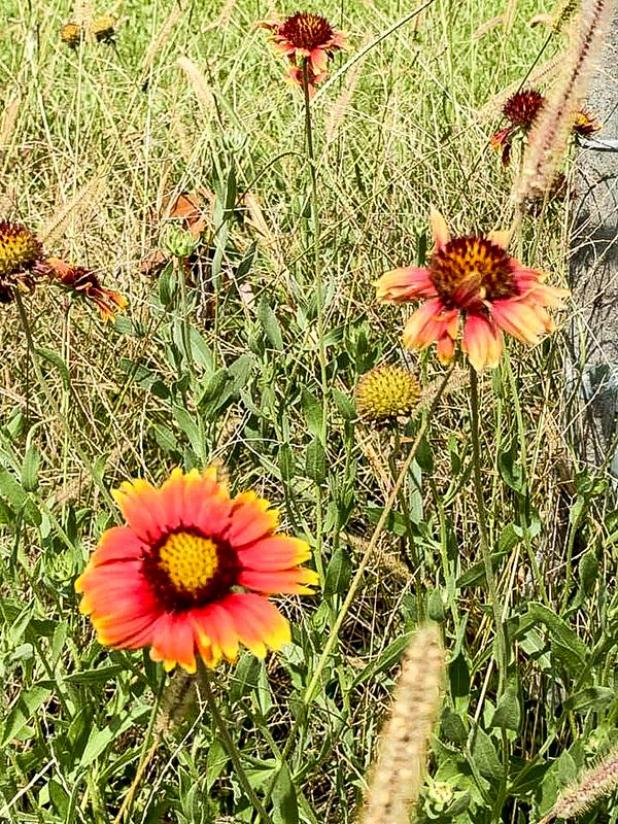
Centerville's Wildflower Walk
The Centerville Park beautification project, also known as the Wildflower Walk, has offered some stunning shows of color during the summer.
The donated trees are adapting to the soil and getting better established, and most are thriving, according to Centerville High Ag teacher and park volunteer Steve Nugent.
The crepe myrtle trees seem to have done very well, Nugent said, and they are growing rather quickly, and although the bloom season is drawing to a close, some are still putting out blooms. The varieties that bloom first, such as Arapaho, a dark redish-pink, and Natchez, white bloom, are now seeding out and preparing themselves for the next show of color, which will be leaves turning the reds, yellows, and oranges of fall.
“That fall foliage can be expected in October, as the days grow shorter to trigger the change,” Nugent said. “There are a few trees that seem to be struggling. The redbuds, camellias and a cherry tree are not growing as prolifically as the crepe myrtles, and seem to be having a tougher time adapting to the clay soil of the park. Although fertilizer helps, the intense heat, rainfall and pH of the soil are issues that each tree must overcome on its own, and often trees struggle for a year or two before they adjust and respond with prolific growth and blooms.”
Nugent said that many of the park’s visitors have enjoyed the thousands of blooming wildflowers that line certain sections of the pathway. The walk was initially seeded with several varieties of flowers, but only about half have taken and established themselves, now that the summer proved to be rainy enough to help the perennials gain footing. The wildflowers are past their bloom show, and are seeding out. They will be cut back in a few days to force them to send growth to underground roots and prepare for overwintering.
“Those that bloomed will be back in the early spring 2021, but in the meantime, I have to try and get a handle on the foxtail grass and some yellow nutsedge that are out-competing some of the seeds we planted,”
Nugent explained. “You must be very careful when applying selective herbicides that target specific pest grasses. I don’t spray anything that is harmful to people or pets, of course, and I certainly don’t spray when the bees and other pollinators are visiting the park. Honeybee populations are only a fraction of what they used to be a few decades ago, and we humans really need those honeybees, they do a lot more than pollinate flowers for us, so nothing is applied to the flowers that will harm bees or the honey they make.”
He said he plans to re-adjust the seeding program the park is re-seeded this fall. “I see now what seeds can out-compete the grasses and sedges, and I will focus on those when the time comes,” he said. “Although all of the park’s sections were seeded with wildflowers back in February and March, most of the seeds germinated, but about half did not grow to maturity. We experienced an eight-week long drought after the seeding, and that was too much for some of the young plants. The red and orange poppy plants didn’t make it, neither did some of the low growing purple flowers, so we still keep our fingers crossed as we re-seed this upcoming season.
Local volunteers and students will be checking the tried-and-true Farmer’s Almanac for long-term forecasts for rain in 2021.
“Maybe we can get more flowers to bloom this second year,” Nugent said. “The pandemic threw a kink in everyone’s plans, and I had hoped to maintain some of the park beds with volunteer and student help, even involving the FFA club, but I guess the Covid-19 virus had other plans! The flowers that did take hold did put on a spectacular show, the white daisies and yellows of the black-eyed-susans, and the combination beds with annuals were wonderful to see.
“Next season should be better,” he concluded, “but we have to hope for good weather in the meantime. A huge thanks does out to those people that have helped and continue to do so with the park. It means a lot to see that some volunteers have done a little weed-trimming or helped with a tree tie-down, and these little favors are noticed by visitors and much appreciated. After the flower beds are cut, the trees will be mulched and fertilized for over-wintering, and the beds will be re-seeded during the winter and early fall … so we hope to have a prettier walk next year!”
